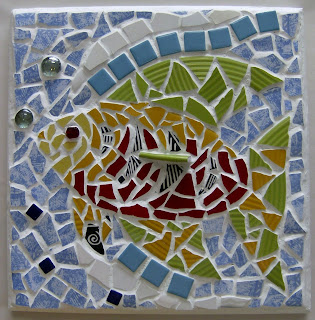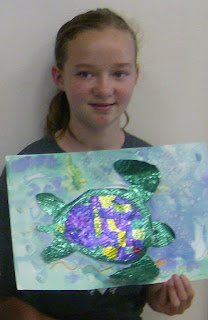For our final week of ART Camp, we made mosaics!
This is one of my favorite all time projects, and I just love sharing the process with our young artists!

We built mosaics both large and small. We started with this little pocket mirror so we could learn how to design, glue, and grout. These were tiled on both sides. Abbi also made a drawstring pouch for hers. Here are the front and back views of her pocket mirror.
 Next, we drew a simple design on a larger piece of wood and filled it in with tiles and broken ceramic pieces, such as broken china and dinner plates.
Next, we drew a simple design on a larger piece of wood and filled it in with tiles and broken ceramic pieces, such as broken china and dinner plates. We could also choose seashells, beads, acrylic marbles, wood shapes, and lots of other things.

This picture shows part of our workspace.
We glued everything down and let it all dry overnight.

 After the glue was dried, we grouted the mosaic with plaster of Paris. We mixed only a little at a time because it hardens very quickly. We spread it all over the mosaic with a palette knife and then a rubber spatula to get the grout into all the cracks.
After the glue was dried, we grouted the mosaic with plaster of Paris. We mixed only a little at a time because it hardens very quickly. We spread it all over the mosaic with a palette knife and then a rubber spatula to get the grout into all the cracks.Then we waited about 20 minutes for it to set. The next step was to wipe off the excess grout with a damp sponge to make sure we could see all of the tiles.
After another 24 hours, it was time to wipe the whole thing with a soft clean rag and make it shine! Abbi also added a little clown face to her cartwheeling clown. She could paint the edges of the mosaic too, but we ran out of time. (She'll probably do that at home.)




















































